Mehrtash Harandi
Curvature Learning for Generalization of Hyperbolic Neural Networks
Aug 24, 2025Abstract:Hyperbolic neural networks (HNNs) have demonstrated notable efficacy in representing real-world data with hierarchical structures via exploiting the geometric properties of hyperbolic spaces characterized by negative curvatures. Curvature plays a crucial role in optimizing HNNs. Inappropriate curvatures may cause HNNs to converge to suboptimal parameters, degrading overall performance. So far, the theoretical foundation of the effect of curvatures on HNNs has not been developed. In this paper, we derive a PAC-Bayesian generalization bound of HNNs, highlighting the role of curvatures in the generalization of HNNs via their effect on the smoothness of the loss landscape. Driven by the derived bound, we propose a sharpness-aware curvature learning method to smooth the loss landscape, thereby improving the generalization of HNNs. In our method, we design a scope sharpness measure for curvatures, which is minimized through a bi-level optimization process. Then, we introduce an implicit differentiation algorithm that efficiently solves the bi-level optimization by approximating gradients of curvatures. We present the approximation error and convergence analyses of the proposed method, showing that the approximation error is upper-bounded, and the proposed method can converge by bounding gradients of HNNs. Experiments on four settings: classification, learning from long-tailed data, learning from noisy data, and few-shot learning show that our method can improve the performance of HNNs.
Unleashing Diffusion Transformers for Visual Correspondence by Modulating Massive Activations
May 24, 2025Abstract:Pre-trained stable diffusion models (SD) have shown great advances in visual correspondence. In this paper, we investigate the capabilities of Diffusion Transformers (DiTs) for accurate dense correspondence. Distinct from SD, DiTs exhibit a critical phenomenon in which very few feature activations exhibit significantly larger values than others, known as \textit{massive activations}, leading to uninformative representations and significant performance degradation for DiTs. The massive activations consistently concentrate at very few fixed dimensions across all image patch tokens, holding little local information. We trace these dimension-concentrated massive activations and find that such concentration can be effectively localized by the zero-initialized Adaptive Layer Norm (AdaLN-zero). Building on these findings, we propose Diffusion Transformer Feature (DiTF), a training-free framework designed to extract semantic-discriminative features from DiTs. Specifically, DiTF employs AdaLN to adaptively localize and normalize massive activations with channel-wise modulation. In addition, we develop a channel discard strategy to further eliminate the negative impacts from massive activations. Experimental results demonstrate that our DiTF outperforms both DINO and SD-based models and establishes a new state-of-the-art performance for DiTs in different visual correspondence tasks (\eg, with +9.4\% on Spair-71k and +4.4\% on AP-10K-C.S.).
Exemplar-Free Continual Learning for State Space Models
May 24, 2025Abstract:State-Space Models (SSMs) excel at capturing long-range dependencies with structured recurrence, making them well-suited for sequence modeling. However, their evolving internal states pose challenges in adapting them under Continual Learning (CL). This is particularly difficult in exemplar-free settings, where the absence of prior data leaves updates to the dynamic SSM states unconstrained, resulting in catastrophic forgetting. To address this, we propose Inf-SSM, a novel and simple geometry-aware regularization method that utilizes the geometry of the infinite-dimensional Grassmannian to constrain state evolution during CL. Unlike classical continual learning methods that constrain weight updates, Inf-SSM regularizes the infinite-horizon evolution of SSMs encoded in their extended observability subspace. We show that enforcing this regularization requires solving a matrix equation known as the Sylvester equation, which typically incurs $\mathcal{O}(n^3)$ complexity. We develop a $\mathcal{O}(n^2)$ solution by exploiting the structure and properties of SSMs. This leads to an efficient regularization mechanism that can be seamlessly integrated into existing CL methods. Comprehensive experiments on challenging benchmarks, including ImageNet-R and Caltech-256, demonstrate a significant reduction in forgetting while improving accuracy across sequential tasks.
MoKD: Multi-Task Optimization for Knowledge Distillation
May 13, 2025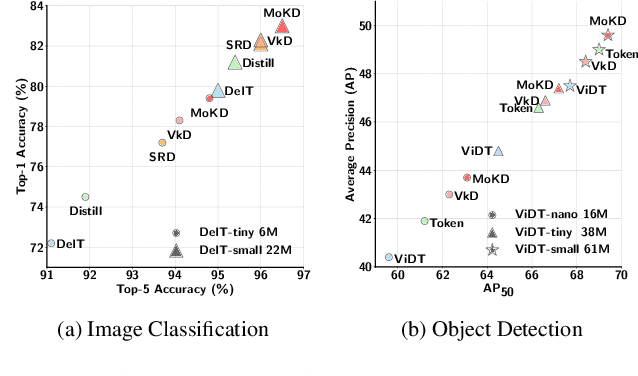
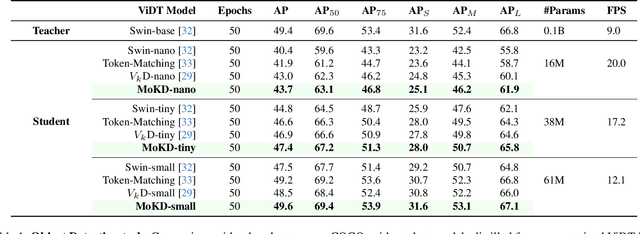
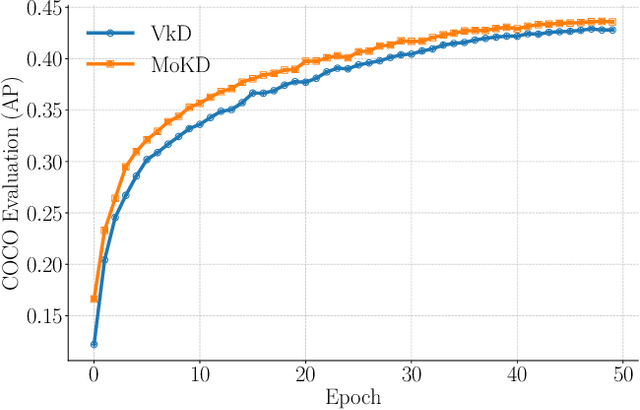
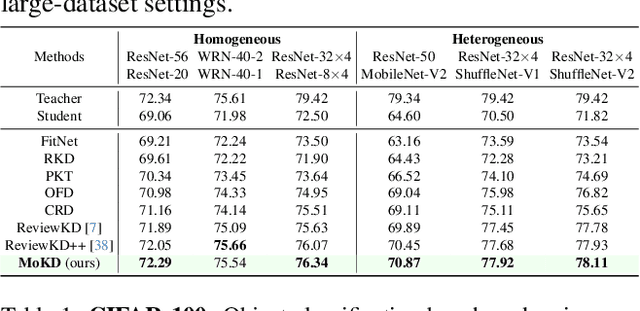
Abstract:Compact models can be effectively trained through Knowledge Distillation (KD), a technique that transfers knowledge from larger, high-performing teacher models. Two key challenges in Knowledge Distillation (KD) are: 1) balancing learning from the teacher's guidance and the task objective, and 2) handling the disparity in knowledge representation between teacher and student models. To address these, we propose Multi-Task Optimization for Knowledge Distillation (MoKD). MoKD tackles two main gradient issues: a) Gradient Conflicts, where task-specific and distillation gradients are misaligned, and b) Gradient Dominance, where one objective's gradient dominates, causing imbalance. MoKD reformulates KD as a multi-objective optimization problem, enabling better balance between objectives. Additionally, it introduces a subspace learning framework to project feature representations into a high-dimensional space, improving knowledge transfer. Our MoKD is demonstrated to outperform existing methods through extensive experiments on image classification using the ImageNet-1K dataset and object detection using the COCO dataset, achieving state-of-the-art performance with greater efficiency. To the best of our knowledge, MoKD models also achieve state-of-the-art performance compared to models trained from scratch.
Optimizing Specific and Shared Parameters for Efficient Parameter Tuning
Apr 04, 2025Abstract:Foundation models, with a vast number of parameters and pretraining on massive datasets, achieve state-of-the-art performance across various applications. However, efficiently adapting them to downstream tasks with minimal computational overhead remains a challenge. Parameter-Efficient Transfer Learning (PETL) addresses this by fine-tuning only a small subset of parameters while preserving pre-trained knowledge. In this paper, we propose SaS, a novel PETL method that effectively mitigates distributional shifts during fine-tuning. SaS integrates (1) a shared module that captures common statistical characteristics across layers using low-rank projections and (2) a layer-specific module that employs hypernetworks to generate tailored parameters for each layer. This dual design ensures an optimal balance between performance and parameter efficiency while introducing less than 0.05% additional parameters, making it significantly more compact than existing methods. Extensive experiments on diverse downstream tasks, few-shot settings and domain generalization demonstrate that SaS significantly enhances performance while maintaining superior parameter efficiency compared to existing methods, highlighting the importance of capturing both shared and layer-specific information in transfer learning. Code and data are available at https://anonymous.4open.science/r/SaS-PETL-3565.
PCGS: Progressive Compression of 3D Gaussian Splatting
Mar 11, 2025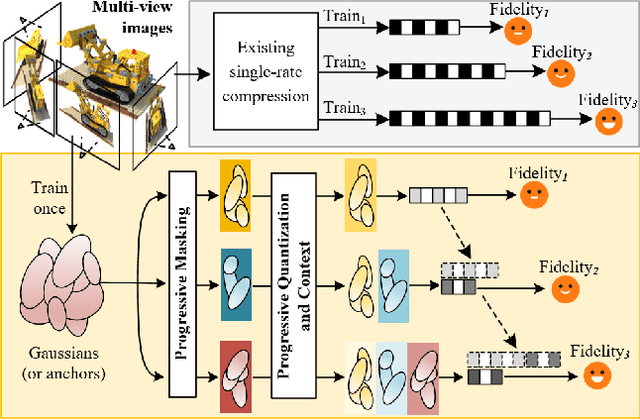
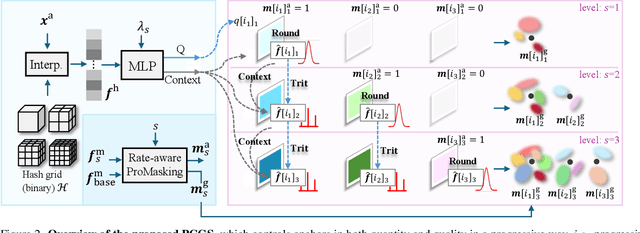
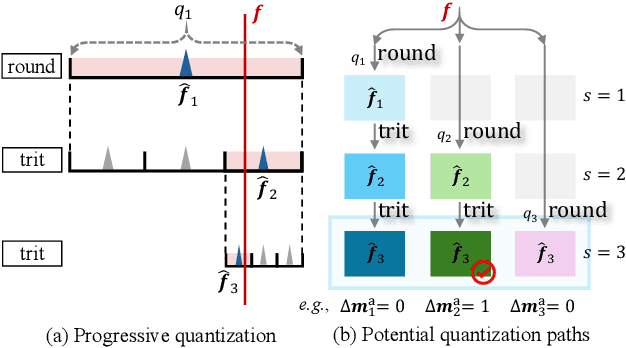

Abstract:3D Gaussian Splatting (3DGS) achieves impressive rendering fidelity and speed for novel view synthesis. However, its substantial data size poses a significant challenge for practical applications. While many compression techniques have been proposed, they fail to efficiently utilize existing bitstreams in on-demand applications due to their lack of progressivity, leading to a waste of resource. To address this issue, we propose PCGS (Progressive Compression of 3D Gaussian Splatting), which adaptively controls both the quantity and quality of Gaussians (or anchors) to enable effective progressivity for on-demand applications. Specifically, for quantity, we introduce a progressive masking strategy that incrementally incorporates new anchors while refining existing ones to enhance fidelity. For quality, we propose a progressive quantization approach that gradually reduces quantization step sizes to achieve finer modeling of Gaussian attributes. Furthermore, to compact the incremental bitstreams, we leverage existing quantization results to refine probability prediction, improving entropy coding efficiency across progressive levels. Overall, PCGS achieves progressivity while maintaining compression performance comparable to SoTA non-progressive methods. Code available at: github.com/YihangChen-ee/PCGS.
Learning from Noisy Labels with Contrastive Co-Transformer
Mar 04, 2025



Abstract:Deep learning with noisy labels is an interesting challenge in weakly supervised learning. Despite their significant learning capacity, CNNs have a tendency to overfit in the presence of samples with noisy labels. Alleviating this issue, the well known Co-Training framework is used as a fundamental basis for our work. In this paper, we introduce a Contrastive Co-Transformer framework, which is simple and fast, yet able to improve the performance by a large margin compared to the state-of-the-art approaches. We argue the robustness of transformers when dealing with label noise. Our Contrastive Co-Transformer approach is able to utilize all samples in the dataset, irrespective of whether they are clean or noisy. Transformers are trained by a combination of contrastive loss and classification loss. Extensive experimental results on corrupted data from six standard benchmark datasets including Clothing1M, demonstrate that our Contrastive Co-Transformer is superior to existing state-of-the-art methods.
HAC++: Towards 100X Compression of 3D Gaussian Splatting
Jan 21, 2025



Abstract:3D Gaussian Splatting (3DGS) has emerged as a promising framework for novel view synthesis, boasting rapid rendering speed with high fidelity. However, the substantial Gaussians and their associated attributes necessitate effective compression techniques. Nevertheless, the sparse and unorganized nature of the point cloud of Gaussians (or anchors in our paper) presents challenges for compression. To achieve a compact size, we propose HAC++, which leverages the relationships between unorganized anchors and a structured hash grid, utilizing their mutual information for context modeling. Additionally, HAC++ captures intra-anchor contextual relationships to further enhance compression performance. To facilitate entropy coding, we utilize Gaussian distributions to precisely estimate the probability of each quantized attribute, where an adaptive quantization module is proposed to enable high-precision quantization of these attributes for improved fidelity restoration. Moreover, we incorporate an adaptive masking strategy to eliminate invalid Gaussians and anchors. Overall, HAC++ achieves a remarkable size reduction of over 100X compared to vanilla 3DGS when averaged on all datasets, while simultaneously improving fidelity. It also delivers more than 20X size reduction compared to Scaffold-GS. Our code is available at https://github.com/YihangChen-ee/HAC-plus.
DoubleDiffusion: Combining Heat Diffusion with Denoising Diffusion for Generative Learning on 3D Meshes
Jan 06, 2025
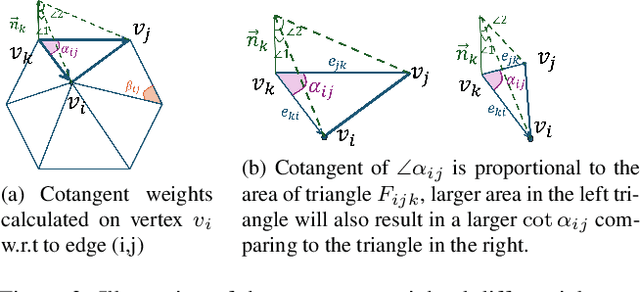

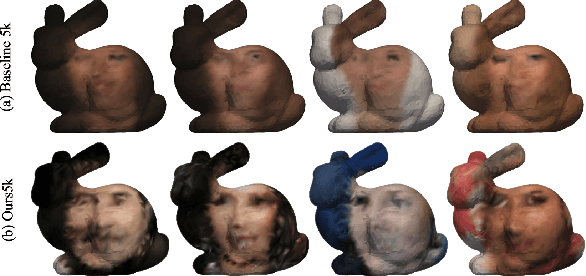
Abstract:This paper proposes DoubleDiffusion, a novel framework that combines heat dissipation diffusion and denoising diffusion for direct generative learning on 3D mesh surfaces. Our approach addresses the challenges of generating continuous signal distributions residing on a curve manifold surface. Unlike previous methods that rely on unrolling 3D meshes into 2D or adopting field representations, DoubleDiffusion leverages the Laplacian-Beltrami operator to process features respecting the mesh structure. This combination enables effective geometry-aware signal diffusion across the underlying geometry. As shown in Fig.~\ref{fig:teaser}, we demonstrate that DoubleDiffusion has the ability to generate RGB signal distributions on complex 3D mesh surfaces and achieves per-category shape-conditioned texture generation across different shape geometry. Our work contributes a new direction in diffusion-based generative modeling on 3D surfaces, with potential applications in the field of 3D asset generation.
Large-Scale Data-Free Knowledge Distillation for ImageNet via Multi-Resolution Data Generation
Nov 26, 2024



Abstract:Data-Free Knowledge Distillation (DFKD) is an advanced technique that enables knowledge transfer from a teacher model to a student model without relying on original training data. While DFKD methods have achieved success on smaller datasets like CIFAR10 and CIFAR100, they encounter challenges on larger, high-resolution datasets such as ImageNet. A primary issue with previous approaches is their generation of synthetic images at high resolutions (e.g., $224 \times 224$) without leveraging information from real images, often resulting in noisy images that lack essential class-specific features in large datasets. Additionally, the computational cost of generating the extensive data needed for effective knowledge transfer can be prohibitive. In this paper, we introduce MUlti-reSolution data-freE (MUSE) to address these limitations. MUSE generates images at lower resolutions while using Class Activation Maps (CAMs) to ensure that the generated images retain critical, class-specific features. To further enhance model diversity, we propose multi-resolution generation and embedding diversity techniques that strengthen latent space representations, leading to significant performance improvements. Experimental results demonstrate that MUSE achieves state-of-the-art performance across both small- and large-scale datasets, with notable performance gains of up to two digits in nearly all ImageNet and subset experiments. Code is available at https://github.com/tmtuan1307/muse.
 Add to Chrome
Add to Chrome Add to Firefox
Add to Firefox Add to Edge
Add to Edge